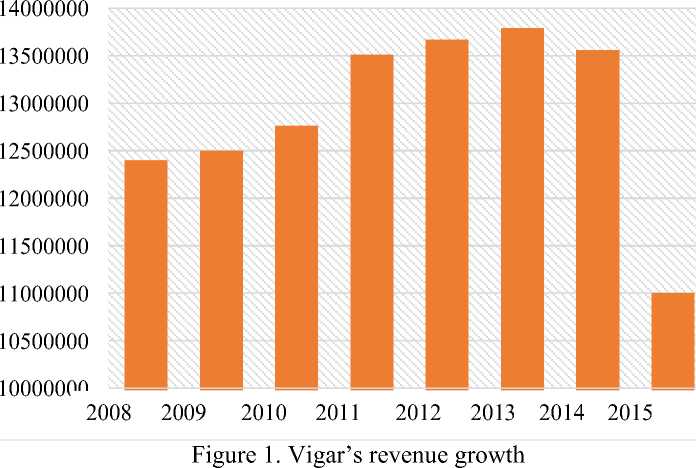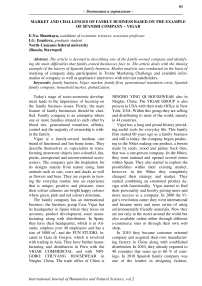Market and challenges of family business based on the example of Spanish company - Vigar
Автор: Shatskaya E.Yu., Esaulova I.G.
Журнал: Международный журнал гуманитарных и естественных наук @intjournal
Рубрика: Экономика и управление
Статья в выпуске: 2 (2), 2016 года.
Бесплатный доступ
The article is devoted to describing one of the family-owned company and identifying the main difficulties that family-owned businesses face to. The article deals with the shining example of the history of Spanish family business. Market analysis was conducted on the basis of studying of company data, participation in Trento Marketing Challenge and available information of company as well as qualitative interviews with relevant stakeholders.
Family business, vigar, market, family firm, generational transition crisis, spanish family company, household market, globalization
Короткий адрес: https://sciup.org/170184305
IDR: 170184305
Текст научной статьи Market and challenges of family business based on the example of Spanish company - Vigar
Today's stage of socio-economic development leads to the importance of focusing on the family business issues. Firstly, the main feature of family businesses should be clarified. Family company is an enterprise where one or more families related to each other by blood ties, generational transition, affinity, control and the majority of ownership is within the family.
Vigar is a family-owned medium size brand of functional and fun home items. They describe themselves as «specialists in transforming monotone objects into colourful, fun, poetic, unexpected and unconventional acces-sories». The company gets the inspiration for its designs mainly from nature using farm animals such as cats, cows and ducks as well as flowers and bees. They are experts in turning the everyday routine into an experience that is unique, positive and pleasant, since their colour schemes are bright happy colours where green, pink and red colours dominate.
The family company has an international business: the business group Casa Vigar has its headquarter in Spain where they focus on accounts, product development, some manufacturing along with distribution. In Spain, they have their headquarter, which is in Alicante, employs over 40 employees and has a size of 5000 m2, and the FUN STUDIO, located in Gata de Gorgos, which is involved with trading in Asia. They have further manufacturing and distribution in Peru with the VIGAR COMMERCIAL and with NIN-GOBO CHUYANG HOUSEWEAR in Ningbo, China. The trade office of China is
NINGBO YING QI HOUSEWEAR also in Ningbo, China. The VIGAR GROUP is also present in USA with their trade Office in New York, USA. Within this group they are selling and distributing to most of the world, namely in 44 countries.
Vigar has a long and proud history providing useful tools for everyday life. This family firm started 60 years ago as a family business and still is today: the company begun producing in the 50ties making one product, a broom made by reeds, wood and palms; back then, that was a one-person company. In the 80ties, they went national and opened several stores within Spain. They also started to explore the possibilities within their existing market; however, in the 90ties they completely changed their strategy and market. They started combining an emotional product design with functionality. Vigar started to find their personality and hereby getting more and more success as a company. In 2000 the Vi-gar’s revolution came: they went international and became more and more aware of using environmentally friendly materials. Now they are not only in the stores around the world but also available online either through different e-commerce sites or through their own web shop.
In 2010 they became costumer oriented company and acquired their own manufacturing factory in China along with established distribution. In 2010, they already exported to 40 countries that sums up to 60 % of earnings. In 2010 Spanish family company was one of the leaders in designing fashion- cleaning tools for the home. They reinvented their homepage, established an e-commerce and entered the social media, so that up until 2013, the company has continued to grow despite the global economic difficulties. In 2014, family-controlled company Vigar stopped the collaboration with the OEM distributors in USA due some family related problems. This circumstance led to the growth curve, which is temporarily on pause [1]. Revenue growth of Vigar company is represented on Figure 1.

Vigar focuses on six bil co ning their products, name esi pr ct development, moulds, in on, es, ting and not least tex se g. ar evolved from a compan at y o d their creative and fun pro s f ean to now offering five diffe pro t c o-ries.
Products of the fam co y ar could be divided in the fo ing ego
-
1. The first category i ean and i-ties where they concent on duc or cleaning floors, removin st, ing n-dows and different produ for g a d the sink area.
-
2. The second catego hey plo is utilities for the kitchen. s c ory y describe as «Table tops ad ». I n-tains equipment for food par n a ll as products for easing niz . I o contains fabric products tab ps g with gadgets for wine an er s.
-
3. The third category or t athm. Here they focus on pr ts bat d shower, bath sink produc w s u es for cleaning the bathroom
-
4 nd s t our ategory within he pa and nta organizational
rod of aun
-
5 e fi and we tegory, within iga oes foc on home area, but
ath fu ice plie
T om y d not y focus on the rea pro s b lso the more basic nes ey e d ed products into hre ego
-
1 ic, is or ed and focused
n f on ms
-
2 cti w th sign is in cen-
- um
-
3 ativ the ego s the only one
he l of pro ca ries are present cle g a ll a fice
-
S sh ily pa Vigar makes a
rea ort ow ir p cts in the most eco ed rna l ss, like the Inern al e Ho wear show in hic Ante Fra rt, the Interna-on ous ear Me n Hong Kong, nd sh off r p cts in Paris at he on bje w,
T om y h nly distributor in aly ich M uali ut they have a big market for cleaning utilities, which is nearly 50 %. The sales in this country peaked in 2011 but then dropped every year until this year where they have the lowest income so far.
The reference market for Vigar is the household market, which is defined by the goods and products that are tangible and movable personal properties.
The household market, according to the Thomson Reuters Business classification, could be divided into three sub-markets, which are [2]:
-
1. consumer electronics;
-
2. home furnishing;
-
3. appliances, tools and housewares.
The company works specifically is the third sub-category as produces housewares and cleaning tools for the house. The classification allows us to pinpoint which are Vigar’s competitors and divide them between direct and indirect competitors. The direct competitors are the ones who have similar characteristics to Vigar or which play in the same market sub-category; the indirect competitors are the ones that offer substitutional goods or play in the other two sub-categories: consumer electronics and home furnishing. Examples of direct and indirect competitors can be seen on Figure 2.
Vigar’s target is generally women between 18 and 50 years old, which have a medium expenditure level, or a medium income. To be more specific since the target is quite large, we can also say that their target is interested not only in products that are useful but they are rather attracted from the design and creative aspect.
The business often represents a key part of a family's financial wealth but also of that family's tradition and legacy.
Competitors
Direct
-
• Pylones
-
• Vileda
-
• Alessi
-
• SpBemer
-
* Tiger
-
• Scotch Brite
-
• Koziol
-
• Fred & Friends
-
• Zak! Designs
Indirect
-
• Ikea
-
• Miele
-
• Bosh
-
• Dyson
-
• Braun
-
• Leroy Merlin
-
• Maison Du Monde
-
• ALoja do Gato Preto
-
• Aki
Figure 2. Direct and indirect competitors of Vigar
Undoubtedly, the job of operating a family business is frequently complicated by friction arising from rivalries involving a family members who hold positions in the business, or at least derive income from it.
The financial problem of the company has mostly happened due to lack of family firm’s awareness of the importance of timely planning for intergenerational business transfer, resulting in ill-prepared successions endangering Vigar’s survival [3].
Moreover, there is a misunderstanding among older family members and young ones. It should be noted, that older family member of Vigar company need to step back and realize that the information that younger generations bring to their business can be vital to attracting new customers.
Thus, the generational transition crisis exists within Vigar company. Undoubtedly, younger family members may come in with their own ideas about how to win new customers and more productively run day-to-day operations, but older family members might not listen. Therefore, older generation should understand that sustainability of Vigar is not only about managing transitions within the family, but also about taking a long-term outlook on the wider sustainability agenda – promoting economic, environmental and social responsibility.
This is especially true of family businesses that have been passed down from previous generations, with little having been changed over time. One solution might be to come up with an agreement to allow younger-generation family members to add one new feature on a periodic basis. Older generations should be willing to let younger leaders make those changes if it improves the business. Developing a shared vision based on family values is an essential part for long-term family business success.
Also, there is another disadvantage which is lack of family business specific management and entrepreneurship education. Those instruments help to manage a company in a better and right way.
To sum up, little is known yet about the existing institutional frameworks and instruments benefiting family businesses, and about their working methods and effects. Family companies have to cope with specific challenges not inherent to non-family businesses or affecting these to a lower extent. However, there is a great benefit of family-owned companies. Family businesses tend to focus on the firm’s long-term sustainability rather than realising short-term profits and on realising generational changes in ownership and management. Within family businesses, there is a strong interrelationship between the family and the business. In contrast to non-family businesses that are mainly influenced by a single owner or a partnership of few partners, in family businesses the family is at the centre of the company, formally or informally influencing the business.
Список литературы Market and challenges of family business based on the example of Spanish company - Vigar
- Vigar (2016). Available at: http://www.vigar.com/ (accessed 14 November 2016)
- TRBC Sector Classification (2015). Available at: http://financial.thomsonreuters.com/ (accessed 1 November 2016)
- Esposito De Falco S., Family business: ownership governance and management, Giappichelli Editore, Torino. 2016, - 217 p.
- Henry Hutcheson. Dirty Little Secrets of Family Business: Ensuring Success from One Generation to the Next, 2016 - 314 p.
- Aronoff, C., McClure, S., Ward, J. Family Business Succession: The Final Test of Greatness. Palgrave Macmillan US, 2011, 104.
- LeCouvie, K., Pendergast, J. Family Business Succession: Your Roadmap to Continuity. Palgrave Macmillan US, 2014,
- Taylor, L.The Business of Family: How to Stay Rich for Generations. Palgrave Macmillan US, 2015, 194 p.


